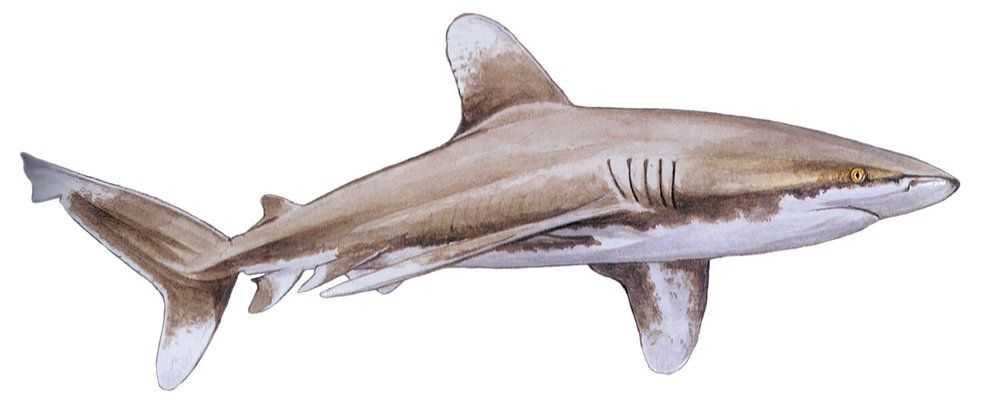Oceanic Whitetip Shark

Species Details
Carcharhinus Longimanus
Carcharhinidae
Carcharhiniformes
Offshore
202 - 370 lbs.
120" - 157"
Oceanic Whitetip Shark (Carcharhinus longimanus) Description
Also known as the silvertip shark, Brown Milber’s sandbar shark, and oceanic white-tipped whaler, the Oceanic Whitetip Sharks are remarkable for their long, wing-like pectoral fins and rounded dorsal fins. Their dorsal, pectoral, and caudal fins are notable for their white tips which become prominent during adulthood; these white marks also account for their name. C. longimanus is a medium-sized requiem shark with a somewhat flattened body.
They reach maturity between 6 and 9 years of age and can live up to 22 years.
Diet and Size
The Oceanic Whitetip Sharks feed primarily on bony fishes and cephalopods. They prey on marlin, tuna, mackerels, and barracuda, among others. They also add sea turtles, squids, stingrays, sea birds, and even garbage to their diet.
On average, Oceanic Whitetip Sharks can grow up to 10 feet in length and weigh up to 370 pounds. In previous decades, sharks of the same species weighed significantly lower, setting around 120 pounds on the weighing scale.
Female Oceanic Whitetip Sharks tend to grow larger than the males by 4 inches. They reach maturity at around the same time.
Interesting Facts About the Oceanic Whitetip Shark
- Oceanic Whitetip Shark meat is a popular ingredient for shark fin soup. Primarily due to that, the Oceanic Whitetip Shark is now considered “critically endangered”.
- Previous reports have shown that they have attacked ship and plane wreck survivors, making them one of the most perilous sharks to humans. They are highly unpredictable and reckless. They are said to have killed many of the wreck survivors in a feeding frenzy when the Nova Scotia ship was sunk off the South African coast; only one-fifth of the original 1,000 passengers survived.
Fishing Techniques
Pelagic sharks like this species have been overly fished due to bycatch, a term used to describe any fish that is unintentionally caught especially through purse-seining. Purse-seining means setting a circular wall or trap around the fish, and ‘pursing’ the bottom together to catch them. Anglers more commonly use longlines or drift nets in fishing them.
However, due to their declining population, Oceanic Whitetip Sharks are now fully protected since 2013 under the Wildlife Act of 1978 and international agreements including the Inter-American Tropical Tuna Commission or IATTC. Fishers who accidentally capture the said shark species are not entirely forbidden from taking the said fish but they will be reported.
Habitat and Distribution
Oceanic Whitetip Sharks thrive in the pelagic zones, specifically in tropical and warm temperate waters worldwide. They abound in temperatures between 64 to 82 °F. They live in deep, open oceans. Due to their commercial value both in the fish meat industry and the shark fin trade, the Oceanic Whitetip Shark’s number has significantly declined. They used to be the most abundant shark species along with the blue shark and the silky shark, but people have been fishing them for their highly edible meat and their skin.
They prefer swimming in off-shore areas as deep as 500 feet. They can specifically be found in the western Atlantic Ocean and eastern Pacific like in southern California and Galapagos. They are also largely sighted in Hawaii, Tuamoto Islands, and Samoa.







